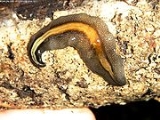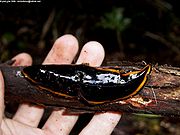
Terricola
Encyclopedia

Common name
A common name of a taxon or organism is a name in general use within a community; it is often contrasted with the scientific name for the same organism...
Land planarians (Platyhelminthes, Tricladida, Geoplanidae) is an understudied but important group of flatworms that belong to the soil ecosystem.
These flatworms range between 1 and 20 cm in size, and are predators of other invertebrates such as earthworm
Earthworm
Earthworm is the common name for the largest members of Oligochaeta in the phylum Annelida. In classical systems they were placed in the order Opisthopora, on the basis of the male pores opening posterior to the female pores, even though the internal male segments are anterior to the female...
s, snail
Snail
Snail is a common name applied to most of the members of the molluscan class Gastropoda that have coiled shells in the adult stage. When the word is used in its most general sense, it includes sea snails, land snails and freshwater snails. The word snail without any qualifier is however more often...
s, slug
Slug
Slug is a common name that is normally applied to any gastropod mollusc that lacks a shell, has a very reduced shell, or has a small internal shell...
s, insect
Insect
Insects are a class of living creatures within the arthropods that have a chitinous exoskeleton, a three-part body , three pairs of jointed legs, compound eyes, and two antennae...
s and chelicerates, which they hunt for, attack and capture using physical force and the adhesive and digestive properties of their mucus. They lack water-retaining mechanisms and are therefore very sensitive to humidity variations of their environment.
Because of their limited ecological requirements, some species have been proposed as indicators of the conservation state of their habitats. They are generally animals with low vagility and with very specific habitat requirements, so they can be also used to accurately determine the distribution of biogeographic zones. Today the fauna of these mostly rather fragile animals is being used to select conservation priorities in the Atlantic rainforest in southern Brazil
Brazil
Brazil , officially the Federative Republic of Brazil , is the largest country in South America. It is the world's fifth largest country, both by geographical area and by population with over 192 million people...
.
At the other extreme, one species in this family, Platydemus manokwari
Platydemus manokwari
Platydemus manokwari, also known as the New Guinea flatworm, is a species of large predatory land flatworm. It is a terrestrial turbellarian in the family Geoplanidae. It is an invasive species....
has become an invasive species
Invasive species
"Invasive species", or invasive exotics, is a nomenclature term and categorization phrase used for flora and fauna, and for specific restoration-preservation processes in native habitats, with several definitions....
in both disturbed and wild habitats in the Pacific Islands
Pacific Islands
The Pacific Islands comprise 20,000 to 30,000 islands in the Pacific Ocean. The islands are also sometimes collectively called Oceania, although Oceania is sometimes defined as also including Australasia and the Malay Archipelago....
, and has damaged the endemic land snail
Snail
Snail is a common name applied to most of the members of the molluscan class Gastropoda that have coiled shells in the adult stage. When the word is used in its most general sense, it includes sea snails, land snails and freshwater snails. The word snail without any qualifier is however more often...
faunas.
Diversity
The Family Geoplanidae is composed of four subfamilies:- Rhynchodeminae: the oldest family, characterized by having only two eyes in the anterior end of the body
- Bipaliinae, consisting of Asiatic species that have a half-circle head shape
- Geoplaninae, the most modern family of terrestrial flatworms; it includes land planarians from south America and Oceania
- Microplaninae
Although there are over 820 known species of Geoplanidae in the world, the diversity of land planarians is still very poorly known, because there are so few number of researchers investigating this group of animals.
Feeding and predatory behavior
"If contact with food is made, and the planarian is ready to feed, arousal and predatory behaviour will occur" (Neck, 1987)Despite their delicate aspect these terrestrial flatworms are voracious predators.
All planarians feed through a muscular and reversible pharynx located in ventral side of the body. The pharynx is an extensible tube-like mouth, it bears complex muscular coat that specialized as a penetration organ for those planarians that feed on arthropods; or as a grasping for those planarians that feed on other soft bodied invertebrates such as earthworms. All pharynxes are equipped with glandular secretions that externally digest and dissolve their prey.
As part of the soil ecosystem land planarians feed mainly on other invertebrates such as earthworms, slugs and snails, termites, isopods, and other land planarians. Two facts prove the effectiveness of land planarians as predators:
- Some species of land planarians have become invasive pest species. The New ZealandNew ZealandNew Zealand is an island country in the south-western Pacific Ocean comprising two main landmasses and numerous smaller islands. The country is situated some east of Australia across the Tasman Sea, and roughly south of the Pacific island nations of New Caledonia, Fiji, and Tonga...
flatworm, Artioposthia triangulata, and the AustraliaAustraliaAustralia , officially the Commonwealth of Australia, is a country in the Southern Hemisphere comprising the mainland of the Australian continent, the island of Tasmania, and numerous smaller islands in the Indian and Pacific Oceans. It is the world's sixth-largest country by total area...
n flatworm, Caenoplana alba, have been introduced in the British IslesBritish IslesThe British Isles are a group of islands off the northwest coast of continental Europe that include the islands of Great Britain and Ireland and over six thousand smaller isles. There are two sovereign states located on the islands: the United Kingdom of Great Britain and Northern Ireland and...
and are considered to be pest species since they prey upon earthworms and thus may negatively affect soil structure and fertility.
- A species of land planarian, Platydemus manokwariPlatydemus manokwariPlatydemus manokwari, also known as the New Guinea flatworm, is a species of large predatory land flatworm. It is a terrestrial turbellarian in the family Geoplanidae. It is an invasive species....
has been used as a biological control of the introduced giant African snail Achatina fulica in HawaiiHawaiiHawaii is the newest of the 50 U.S. states , and is the only U.S. state made up entirely of islands. It is the northernmost island group in Polynesia, occupying most of an archipelago in the central Pacific Ocean, southwest of the continental United States, southeast of Japan, and northeast of...
, MaldivesMaldivesThe Maldives , , officially Republic of Maldives , also referred to as the Maldive Islands, is an island nation in the Indian Ocean formed by a double chain of twenty-six atolls oriented north-south off India's Lakshadweep islands, between Minicoy Island and...
, Irian Jaya, and GuamGuamGuam is an organized, unincorporated territory of the United States located in the western Pacific Ocean. It is one of five U.S. territories with an established civilian government. Guam is listed as one of 16 Non-Self-Governing Territories by the Special Committee on Decolonization of the United...
.
Some land planarians show hunting behaviour, using chemical signals to detect their prey. Most land planarians have chemical sensory organs in the anterior part of the body, such as sensory pits and epidermal folds which serve as chemical radars for detecting their food. The mucus trails from the slime of slugs, snails and other planarians orient planarians towards their prey.
Different species of land planarians use different techniques for capturing and immobilizing their prey, such as entrapment with sticky mucus and immobilization by physical force.
Cannibalism has been observed in land planarians.

